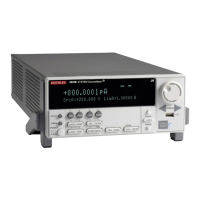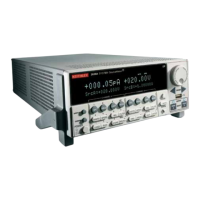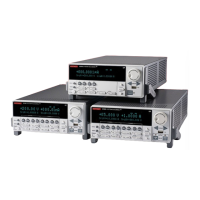ies 2600B System SourceMeter® Instrument Reference Manual Section 3:
2600BS-901-01 Rev. B / May 2013 3-45
Figure 68: Using a timer for an SDM cycle
Timer action overruns
The timer generates an action overrun when it generates a trigger event while a timer delay is still in
progress. Use the status model to monitor for the occurrence of action overruns (for details, see the
Status model (on page 5-14, on page E-1
)).
Using timers to perform pulse mode sweeps
Timers can also be used to control the pulse width during a pulsed sweep. To create a pulse train, a
second timer must be used to configure the pulse period. The examples below show a single pulse
output and a pulse train output.
The SMU end pulse action smuX.trigger.endpulse.action must be set to
smuX.SOURCE_IDLE in order to create a pulse.
Single pulse example:
The programming example below illustrates how to use a single timer to control the pulse width of a
single-shot pulse measurement. The programming example configures the timer and SMU as follows:
Timer 1: Pulse width timer
• Set the delay attribute of a timer equal to the appropriate pulse width.
• Configure the timer to trigger when the SMU moves out of the arm layer of the trigger model.
• Assign the trigger event generated by the timer to the stimulus input of the SMU end pulse event
detector.
SMU A
• Configure the source action to start immediately by setting the stimulus input of the source event
detector to 0.
• Set the end pulse action to SOURCE_IDLE.
